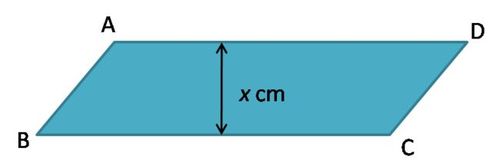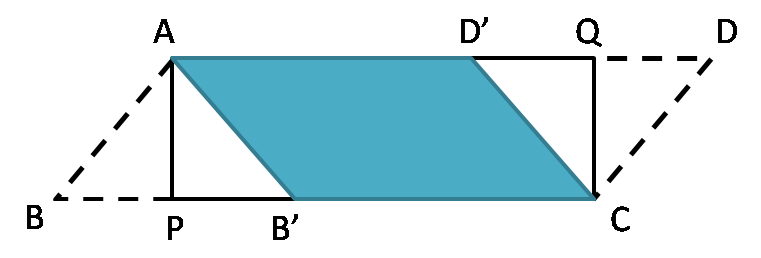Area after folding
 In the figure,
A
B
C
D
is a parallelogram with the height of
x
cm. It is known that
A
B
is 6 cm longer than the height and
A
D
is 3 cm longer than 4 times of the height.
In the figure,
A
B
C
D
is a parallelogram with the height of
x
cm. It is known that
A
B
is 6 cm longer than the height and
A
D
is 3 cm longer than 4 times of the height.

A B and C D are then folded along A P and Q C respectively to form A B ′ and C D ′ respectively. Similarly, B P and Q D are folded along A P and Q C respectively to form P B ′ and Q D ′ .
It is known that A B ′ C D ′ is a rhombus, find the area of A B ′ C D ′ .
Note: The figures are not drawn to scale.
The answer is 135.
This section requires Javascript.
You are seeing this because something didn't load right. We suggest you, (a) try
refreshing the page, (b) enabling javascript if it is disabled on your browser and,
finally, (c)
loading the
non-javascript version of this page
. We're sorry about the hassle.
2 solutions
A P = X , A B = A B ′ = B ′ C = X + 6 , B C = 4 X + 3 . ∴ B B ′ = B C − B ′ C = 3 X − 3 . ⟹ P B ′ = 2 3 X − 3 . A B ′ 2 = A P 2 + P B ′ 2 , ⟹ ( X + 6 ) 2 = X 2 + { 2 3 X − 3 } 2 . Solving the quadratic with +tive answer, X = 9. A r e a o f A B ′ C D ′ = ( X + 6 ) ∗ X = 1 5 ∗ 9 = 1 3 5
given, AP=x , AB=x+6 , AD=4x+3
By pythagoras theorem,
A B 2 = P B 2 + A P 2
or, ( x + 6 ) 2 = x 2 + P B 2
Therefore, P B 2 = 3 6 + 1 2 x
By congruency, BP = PB'
B'C = BC - (2BP) = AB' = AB = Side of rhombus
x+6 = 4x+3 - 2 3 6 + 1 2 x
or, 2 3 6 + 1 2 x = 3x - 3 squaring both side,
or, 144 + 48x = 9 x 2 + 9 -18x
or, -9 x 2 + 66x + 135 = 0
or, -3 x 2 + 22x +45 =0
or, (9-x)(5+3x) = 0
or, x = 9
Therefore B'C=15
Area = 15 * 9
=135